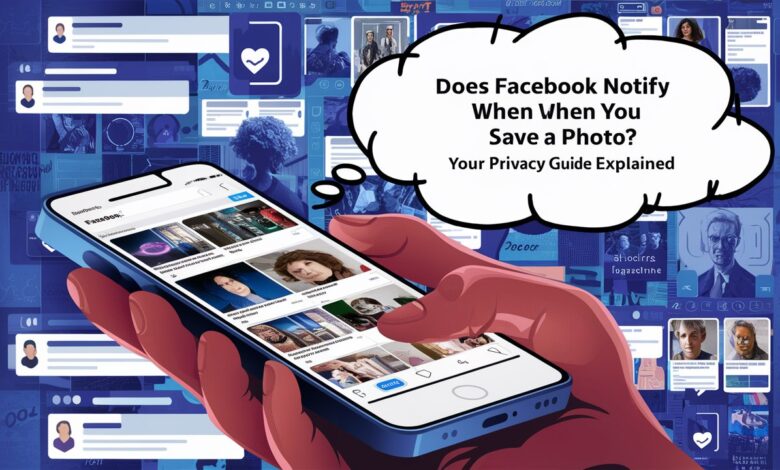Does Facebook Notify When You Save a Photo? Your Privacy Guide Explained

Introduction
In today’s digital landscape, privacy concerns dominate social media interactions, leading many Facebook users to question what actions trigger notifications. A particularly common query revolves around photo saves: Does Facebook alert someone if you save their picture? This question stems from valid anxieties about digital boundaries and content ownership. Understanding Facebook’s notification mechanics is crucial not only for respecting others’ privacy but also for managing your own content strategically. In this comprehensive guide, we’ll dissect Facebook’s policies, clarify misconceptions, and equip you with practical knowledge about photo-saving behaviors. Whether you’re safeguarding your personal albums or ethically engaging with others’ posts, this article demystifies what really happens behind the scenes when you hit “save.”
Understanding Facebook’s Photo Saving Feature
Facebook’s photo-saving functionality allows users to bookmark images for later access without screenshotting or downloading. When you tap the three-dot menu on a public, friend’s, or group post and select “Save photo,” Facebook archives it privately in your “Saved” folder (accessible via your profile menu). This feature is designed for convenience—letting you revisit recipes, memes, or travel inspiration—but operates discreetly. Crucially, saving differs from downloading: Downloaded images are stored locally on your device, while saved photos remain within Facebook’s ecosystem. This distinction is foundational to grasping why notifications aren’t sent, as saving is treated as a personal, internal action rather than active engagement like sharing or reacting.
Does Facebook Notify Users When You Save Their Photos?
The unequivocal answer is no, Facebook does not notify users when their photos are saved. This applies universally—whether the image belongs to a friend, a public page, or a private group where you’re a member. The platform intentionally omits alerts for this action to prioritize user discretion. For instance, if you save a friend’s vacation photo to reference their travel destination later, they’ll receive no indication. Similarly, businesses cannot track saves of their promotional graphics. This policy contrasts sharply with notifications for comments, tags, or shares, which are designed to foster visible interaction. Facebook’s Help Center explicitly confirms this silence around saves, cementing it as a private activity.
Why Facebook Doesn’t Send Notifications for Photo Saves
Facebook’s decision to exclude save-alerts stems from its interpretation of privacy and user experience. Notifying saves could deter engagement; users might hesitate to save content if they fear imposing on posters’ attention. Philosophically, saving resembles bookmarking a webpage—a passive act rather than active participation. From a technical perspective, saves are processed as account-specific metadata (like “liked” posts), invisible to others. Legal considerations also play a role: Unlike public shares, saves don’t amplify content reach or risk copyright violations since saved photos remain hidden. Thus, Facebook treats saves as low-stakes actions unworthy of alerts, reserving notifications for interactions that directly involve other users.
What Actually Happens When You Save a Photo
Upon saving a photo, three key processes occur. First, the image is added to your encrypted “Saved Items” repository, organized chronologically. Second, the original poster’s visibility settings still apply: If they later delete the photo or restrict their account, your saved version may disappear or become inaccessible. Third, saving grants no ownership rights—it’s merely a quick-access tool. For example, saving an acquaintance’s infographic doesn’t let you redistribute it commercially. Importantly, while Facebook doesn’t notify the poster, it does log saves internally for analytics (e.g., showing popular saves in aggregated insights for page admins). However, this data is anonymized and never reveals who saved the content.
How to Save Photos on Facebook: Desktop vs. Mobile
Saving photos is intuitive but varies slightly by device. On desktop, hover over a photo, click the three dots in the top-right corner, and select “Save photo.” In the mobile app, tap the image to expand it, press the three dots (iOS) or bookmark icon (Android), then choose “Save photo.” To view saved items, navigate to your profile’s “Saved” section. Remember that unsaving is equally simple: Revisit the saved item, click the three dots, and select “Unsave.” While saving is discreet, respect intellectual property—avoid reposting saved photos without permission, as this does generate notifications and may violate community standards.
Protecting Your Own Photos from Unwanted Saving
Though you can’t prevent saves outright, proactive privacy settings minimize exposure. Start by adjusting album visibility: Navigate to “Settings & Privacy” > “Privacy Shortcuts” > “Privacy Checkup.” Restrict photo albums to “Friends” or “Only Me” instead of “Public.” Enable “Profile Guard” (available in some regions) to deter unauthorized downloads. Watermarking images adds a layer of protection, discouraging misuse. For high-sensitivity photos, avoid posting them entirely—use Messenger’s disappearing images for temporary sharing. Crucially, regularly audit old posts via “Activity Log” and tighten permissions. While these steps won’t block saves, they reduce accessibility to trusted circles, mitigating risks.
Actions That Do Trigger Facebook Notifications
Unlike saving, many other interactions generate alerts. Tagging someone in a photo instantly notifies them and their network if settings allow. Reacting (e.g., liking) prompts a generic notification, while comments and replies appear in the poster’s alerts. Shares are highly visible: Original posters see who shared their content and where it was reposted. Even screen captures, though untrackable by Facebook, risk exposure if shared publicly. Understanding these distinctions helps navigate social etiquette: Saving is low-profile, but commenting or tagging demands greater awareness of your digital footprint.
Conclusion
Facebook’s photo-saving feature offers a discreet way to curate content without notifying posters—a design choice balancing utility with privacy. While saving bypasses alerts, it doesn’t override copyright or ethical responsibilities; always respect creators’ rights. For personal protection, leverage Facebook’s granular privacy tools to control photo visibility. As social media evolves, staying informed about these mechanics empowers safer, more intentional online behavior. Ultimately, whether archiving memories or gathering inspiration, saving photos remains a silent, private act on the platform.
Frequently Asked Questions (FAQ)
Q1: Can someone see if I save their Facebook photo multiple times?
No. Facebook treats all saves of the same photo as a single action. The poster receives no notifications regardless of how often you save or unsave.
Q2: Do saved photos expire?
Saved photos remain accessible indefinitely unless the original poster deletes them, restricts their privacy settings, or deactivates their account.
Q3: Can I save photos from private accounts?
Only if you’re friends with the account or follow them (for public figures). Photos shared with “Friends” are savable by friends; “Only Me” or custom-restricted posts block saving.
Q4: Does Facebook notify when you download a photo?
No. Downloading (via the “Download” option) also doesn’t trigger notifications. However, downloaded images exist outside Facebook, posing higher misuse risks.
Q5: Can group admins see who saved photos in their group?
No. Admins only access aggregate data like “post engagement,” not individual save activity.
Q6: Are there any exceptions where saving might alert someone?
None. Facebook uniformly suppresses save notifications across profiles, pages, and groups.
Q7: How can I tell if someone saved my photo?
You can’t. Facebook provides no tools to track saves, emphasizing user privacy for this specific action. Focus instead on visible metrics like shares or comments.



